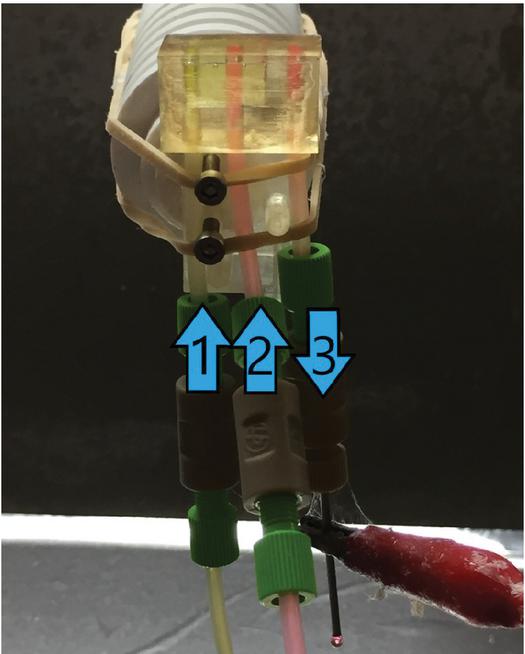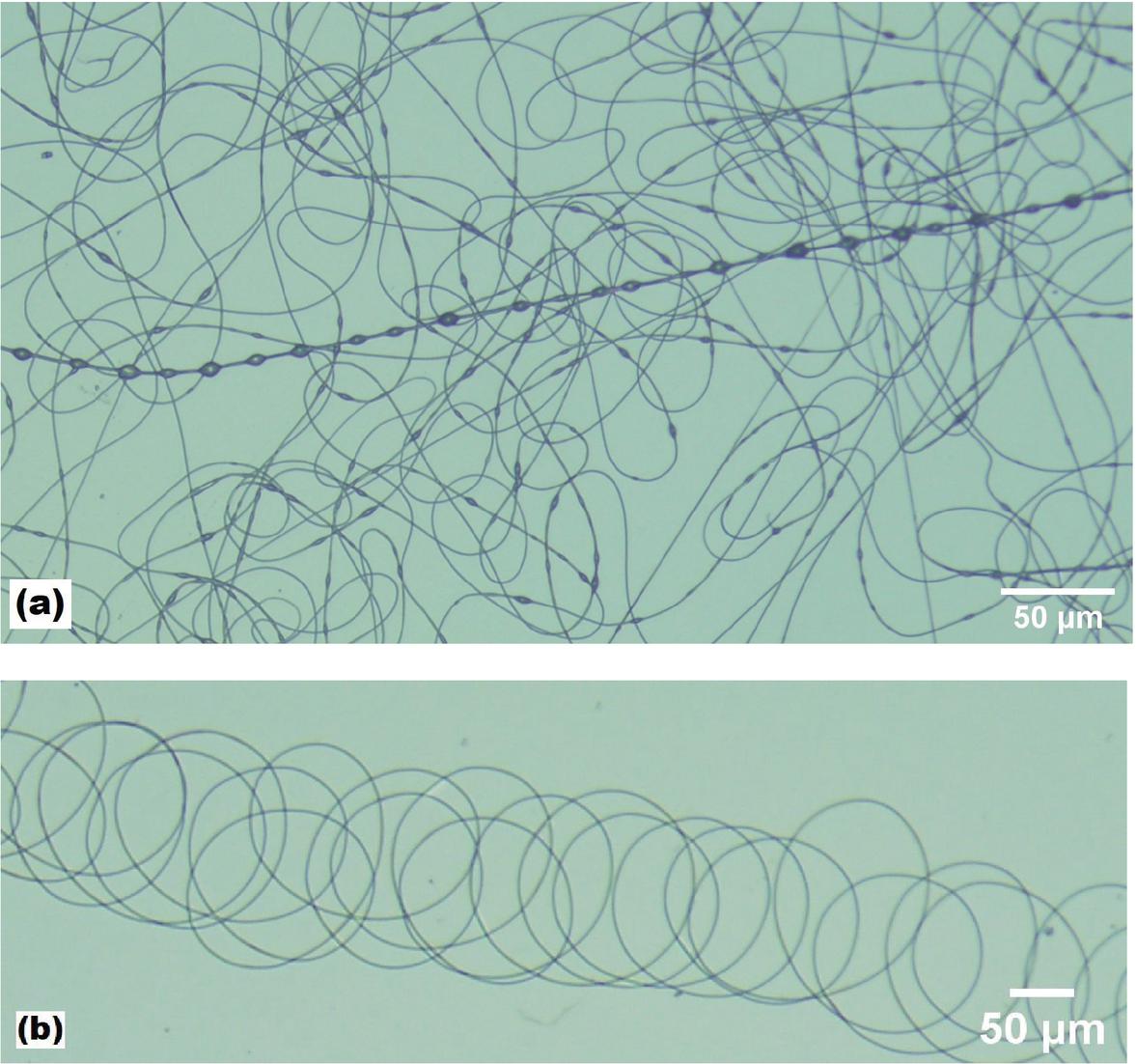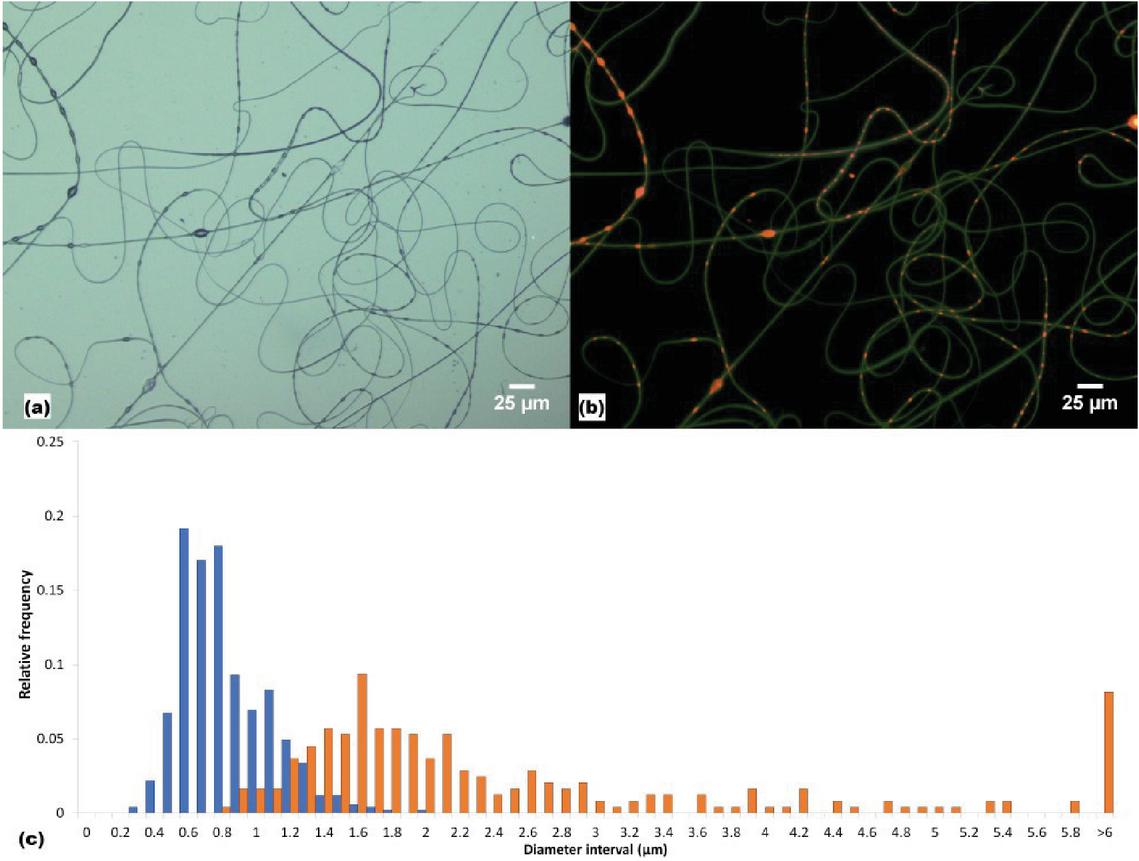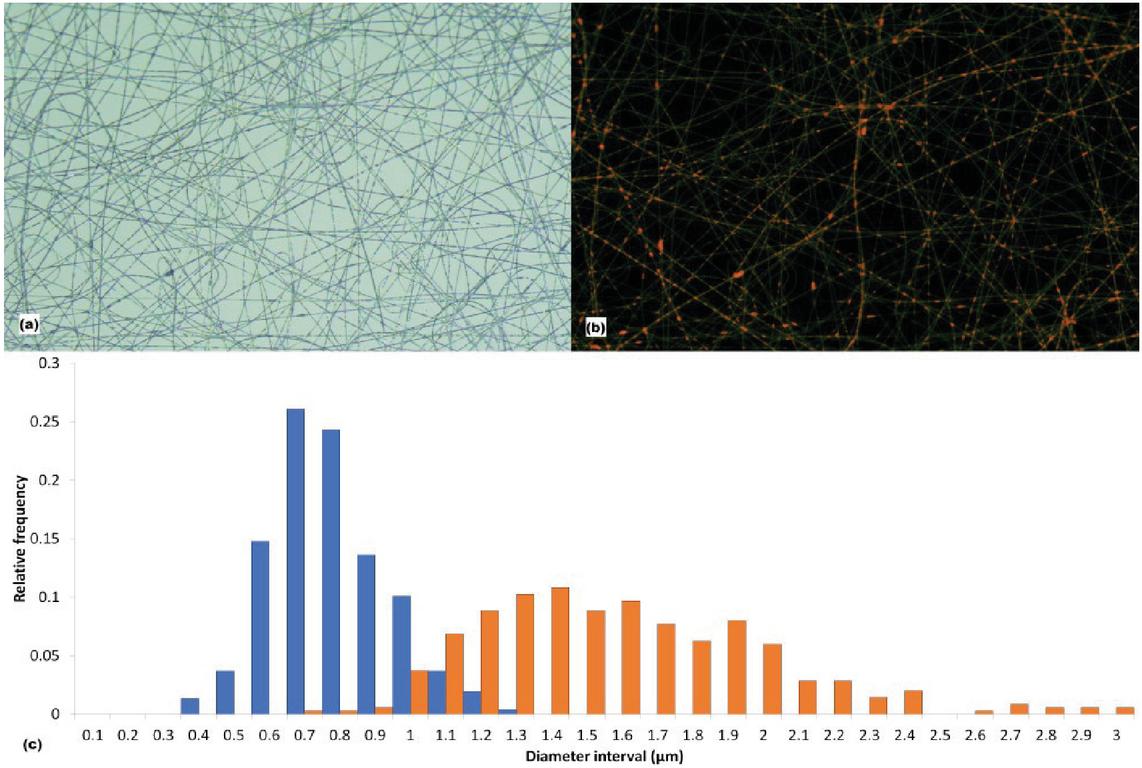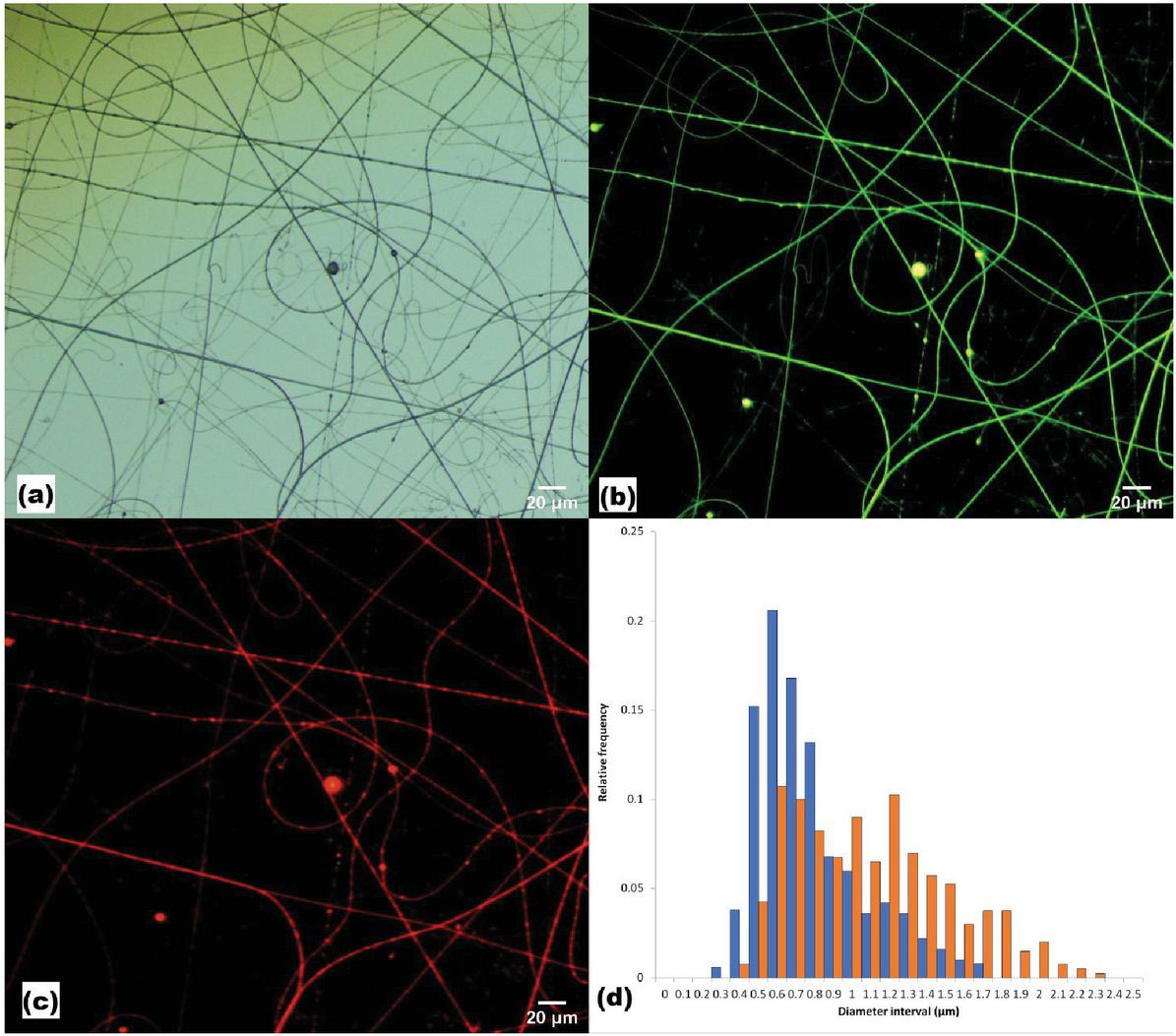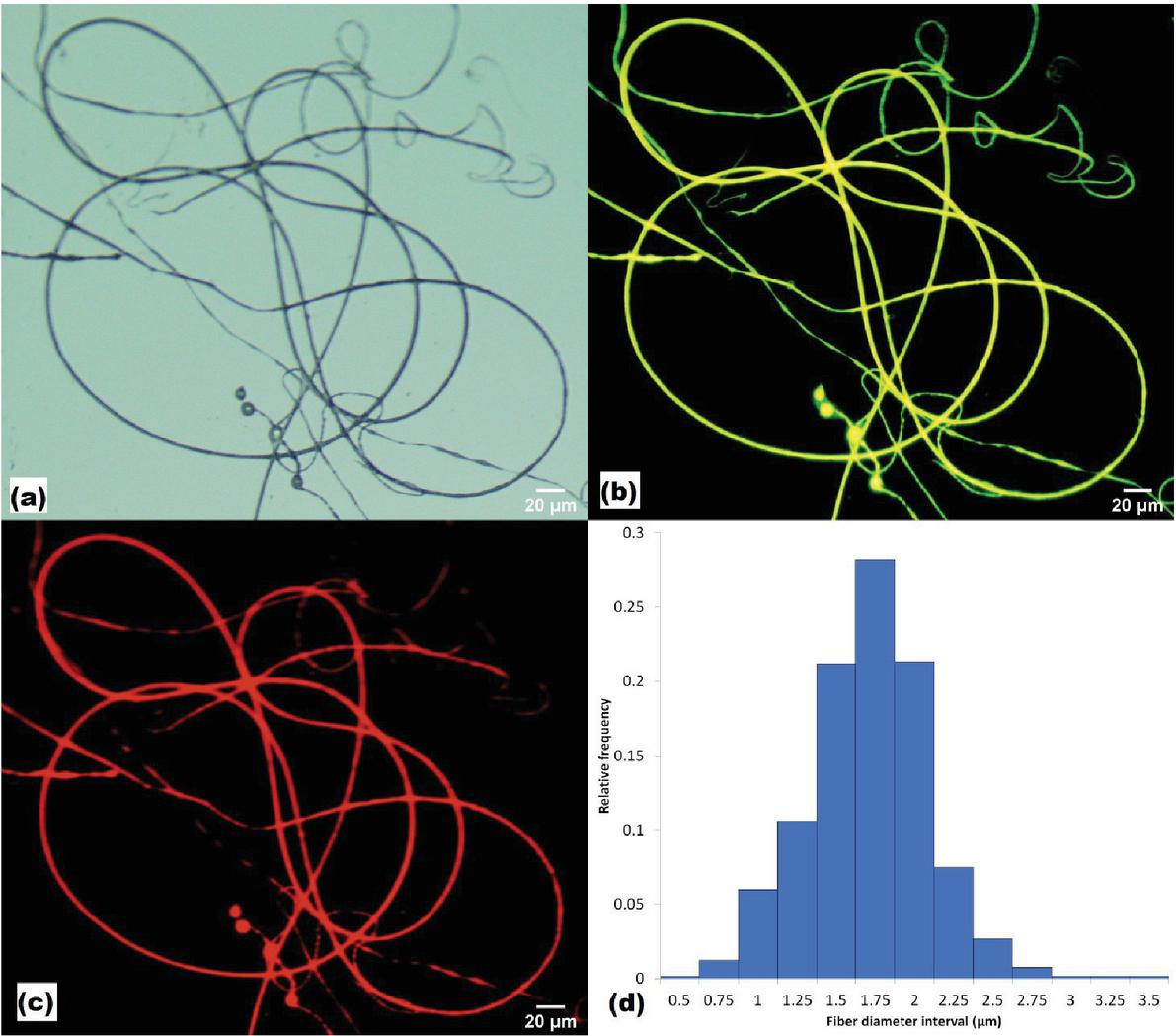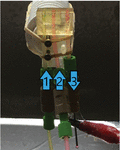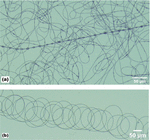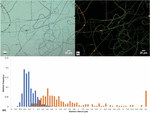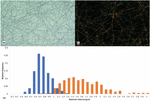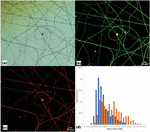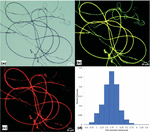Electrospinning with Droplet Generators: A Method for Continuous Electrospinning of Emulsion Fibers
Bjarke N. Jensen1, Thor L. V. Pedersen1 and Peter Fojan1, 2,*
1Department of Physics and Nanotechnology, Aalborg University, Aalborg, Denmark
2Department of Materials and Production, Aalborg University, Skjernvej 4A, 9220 Aalborg, Denmark
E-mail: fp@mp.aau.dk
*Corresponding Author
Abstract
Emulsion electrospinning is a promising method for creating fibrous vehicles for delivery of drugs and bioactive compounds for the medical and food industries. Droplet microfluidics is a potent way of continuously generating controllable emulsion droplets. The incorporation of a droplet generator in an electrospinning setup for continuous electrospinning of emulsion fibers has been investigated. The influence of a droplet generator on the morphology of emulsion fibers has been established through electrospinning of emulsions of grapeseed oil in PVA and gelatine. The droplet generator was found to have no influence on the morphology of fibers. Conventional emulsification methods and droplet generator emulsification has been used to investigate the influence of emulsion droplet sizes on the morphology of emulsion fibers. Increasing the emulsion droplet size was found to create in-fiber droplets with diameters larger than the fiber diameter. The size of the in-fiber droplets was found to be dependent on both material and emulsion size.
Keywords: Emulsion electrospinning, droplet generator, rapid prototyping, 3D printed microfluidics, PVA, gelatine, grapeseed oil.
1 Introduction
Electrospinning is a versatile method for producing nanofibers with properties like high surface area, variable porosity, degradeability, and manageability making them among other things suitable for pharmaceutical applications [1]. The electrospun fibrous structures are used for applications such as drug delivery systems [1], filtration [2], composite materials [3], tissue scaffolds [4, 5], wound dressing [6, 7], and protective clothing [8]. For drug delivery systems electrospinning is used for creating fibrous delivery vehicles that can provide controlled prolonged drug release making them ideal for applications such as administration of high-toxicity drugs [9]. The fibers can be made by direct blend electrospinning, co-axial electrospinning, or emulsion electrospinning [9–11]. Direct blending is possible for drugs that are soluble in the polymer solvent, but are susceptible to poor drug distribution within the fibers, initial burst release profiles, and loss of biomolecules activity due to prolonged contact to the polymer solvent [11]. Co-axial electrospinning creates core-shell fibers by using a needle within a needle creating a co-flow of two immiscible liquids that are simultaneously electrospun into fibers [9]. Emulsion electrospinning is a relatively simple way of creating core-shell fibers that does not require a complex setup [12]. Emulsions allow for protecting solvent sensitive drugs inside droplets that then can be electrospun into fibers where they will be mainly located in the center of the fiber [11]. However, emulsions are susceptible to destabilization through mechanisms like creaming, sedimentation, flocculation, and coalescence thus requiring stabilization molecules while also limiting emulsion electrospinning to the emulsion shelf life [13]. Additionally, classical emulsification methods can cause denaturation or faster oxidation of fragile biomolecules or cells due to heat dissipation and mechanical stress. A promising novel idea that can potentially circumvent these problems could be the integration of microfludics into electrospinning.
Droplet Generator Electrospinning
Droplet generators are microfluidic systems designed for continuous generation of droplets through pressure, shear forces, and viscous forces [14]. Droplet generators have attracted attention lately in the fields of directed molecular evolution and synthetic biology as fast and efficient screening systems for huge mutation libraries [15]. The forces governing the generated droplet size are determined by channel dimensions, and by the flow rates and liquid parameters of both the dispersed and continuous phase [14]. The process of designing a droplet generator best suited for a specific set of parameters can be sped up by using rapid prototyping with a 3D printer. This can increase the design cycle of the droplet generator and the testing of the droplet sizes. By using a droplet generator a continuous generation of droplets can be achieved, which can be electrospun directly from the droplet generator outlet. Such a setup has several advantages over the classical emulsion formation, since the long term stability of the emulsion can be neglected and hence little to no additives and emulsion stabilizers have to be added to the solutions [16]. This makes these fibers better suited for medical applications and the food industry than emulsion based fibers with various emulsion stabilizers [17]. The interaction between the continuous phase and dispersed phase in electrospinning in influenced by the materials chain length, conductivity, hydrolysis, viscosity, solubility, surface tension, and solvents while also in droplet generators influencing the droplet formation rate and droplet size through viscosity and interfacial tension [14, 18–21]. This gives ample ways of controlling the results of droplet generator amplified emulsion electrospinning through polymer parameter adjustment. The emulsion electrospinning production volume can be increased through parallelization of droplet generators [22].
The direct incorporation of a droplet generator into the electrospinning setup has been investigated and the fibers generated during electrospinning have been investigated and characterized.
2 Methods
Electrospinning
A solution of 15% PVA w/v in Milli-Q water was prepared from a mixture of PVA (MW 72,000) (88% hydrolysed) (MP Biomedicals, LLC) and PVA (MW 89,000) (99%+ hydrolysed) (Merck) at a ratio of 1:1 [18].
Tween 80 was added to the PVA solution to a final concentration of 10 mg/L to prevent beading. A solution of 30% gelatine (w/v) was prepared by dissolving gelatine (SFK-Food) in 30% AcOH and Milli-Q water. The reference samples were electrospun using an electrospinner (Yflow A/S) with a connected droplet generator connected to a spinneret with an inner needle diameter of 1.1 mm, and a 19 cm spinneret-collector distance. The potential was set to 18–20 kV. The humidity was between 40–50% relative humidity and the temperature was between 18–20C. The flow rate was set 15 L/min.
Emulsion Electrospinning
A solution of 15% PVA w/v in Milli-Q water was prepared from a mixture of PVA (MW 72,000) (88% hydrolysed) (MP Biomedicals, LLC) and PVA (MW 89,000) (99% hydrolysed) (Merck) at a ratio of 1:1 [18]. Tween 80 was added to the PVA solution to a final concentration of 10 mg/L to prevent beading. A solution of 30% gelatine (w/v) was prepared by dissolving gelatine (SFK-Food) in 30% AcOH and Milli-Q water. Fluorescein (SIGMA-ALDRICH) was gradually added to both the PVA solution and the gelatine solution until the solutions turned bright-green. A solution of commercially available grapeseed oil (Food-line) was prepared by gradually adding nile red (SIGMA-ALDRICH) until the solution turned bright pink.
The emulsions of grapeseed oil (nile red) in 30% gelatine was prepared by using two different methods to create two different emulsion sizes. The first emulsion was prepared by vortexing a dispersion of grapeseed oil in 30% (w/v) gelatine at a ratio of 1:1 at 3000 rpm.
The second was prepared by using a ULTRA TURRAX screw mixing the dispersion of grapeseed oil in 30% gelatine (w/v) (ratio 1:1) at 30k rpm until homogeneous. The emulsion size was evaluated by using a fluorescense microscope (Olympus). The emulsion fibers were electrospun using an electrospinner (Yflow A/S) with a inner needle diameter of 1.1 mm, and a 19 cm spinneret-collector distance. The potential was set to 18–20 kV. The humidity was between 40–50% relative humidity and the temperature was between 18–20C. The flow rate was set 15 L/min. Both emulsion size evaluation and emulsion electrospinning was done immediately after solution preparation.
Droplet Generator Electrospinning
The droplet generator was 3D printed with an Anycubic Photon DLP resin printer with clear resin (Prima Creator). The droplet generator was directly connected to an electrospinner (Yflow A/S) where a solution of 15% PVA (w/v) or 30% gelatine (w/v) was used as the continuous phase and grapeseed oil was used as the dispersed phase. The electrospinning parameters used were a needle with inner diameter of 1.1 mm, and a collector distance of 19 cm. The potential was set to 18–20 kV. The humidity was between 40–50% relative humidity and the temperature was between 18–20C. The flow rate for the polymer solution was set to 15 L/min at a 1:1 mixing ratio between the polymer solution and the nile red oil fraction. This has been used in both cases of Polymer-PVA or Gelatine fluorescein mixture. The droplet formation was allowed to stabilize by waiting one to two minutes before initiating electrospinning of the continuously generated emulsion.
Sample Collection and Evaluation
The samples were collected on microscope glass slides and stored in Petri dishes. Samples were investigated using a fluorescence microscope (Olympus) with bright-field, TRITC filter cube, and FITC filter cube. The fiber diameter and in-fiber-droplet diameters were evaluated manually using Image-J using a minimum of 250 measurements for droplets and a minimum of 500 measurements for fiber diameters.
3 Results and Discussion
Emulsion Electrospinning
The hitherto conventional way of emulsion electrospinning has been the creation of a stable emulsion by either mechanical mixing methods or ultrasound which have then been used for electrospinning. Rapid prototyping of microfluidic systems using 3D printing can replace the emulsification step by creating droplet generators that can be directly connected to the electrospinning needle for electrospinning of continuously in situ generated emulsions. This immediate electrospinning of the emulsion minimizes the requirement of emulsion stabilizer. The effect of incorporating a droplet generator into the electrospinning setup was investigated by using a 3D printed droplet generator which was printed using a DLP resin printer (Anycubic Photon), see Figure 1. During all of the experiments the droplet generator geometry, flow rates, and flow rate ratios between dispersed and continuous phase have been kept constant in order to establish the effect of the polymer on emulsion electrospinning.
Figure 1 Picture of the droplet generator in electrospinning setup. (1): Inlet of continuous phase. (2): Inlet of dispersed phase. (3): Outlet of emulsion for direct electrospinning.
Figure 2 (a) Emulsion fibers of grapeseed oil in 15% PVA (w/v) electrospun using a droplet generator connected to an electrospinning setup. (b) 15% PVA (w/v) fibers spun using a droplet generator connected to an electrospinning setup.
Emulsion fibers electrospun using a droplet generator directly connected to an electrospinner needle as the spinneret are shown in Figure 2(a). The continuously generated grapeseed oil droplets in 15% PVA had an average droplet diameter of 778 m 159m which were fed into the spinneret for instantaneous electrospinning of emulsion fibers. Electrospinning the continuously generated grapeseed oil droplets in 15% PVA produces fibers with droplets that are situated along the fibers. To ensure that these droplets are not the result of polymer beading or induced by the droplet generator, an experiment was performed using the same electrospinning parameters without grapeseed oil.
Figure 3 PVA-grapeseed oil emulsion fibers spun from an emulsion of grapeseed oil in gelatine made using a droplet generator-electrospinner setup. (a) Brightfield, (b) composite image of TRITC filter image overlayed on FITC filter image, (c) Histogram of the fiber diameter (blue) and droplet diameters (orange) in (a).
Electrospinning only PVA without oil using the generator-electrospinner setup produces straight fibers without beading, see Figure 2(b). The droplet generator is thus not the cause of the in-fiber droplet formation in the fibers seen in Figure 2(a), but is instead just a replacement for the emulsion production step.
Fibers obtained by using the droplet generator-electrospinner setup with 15% PVA (fluorescein doped) and grapeseed oil (nile red doped) are shown in Figure 3.
The image was taken with an inverted optical microscope with a FITC filter cube causing the fluorescein doped gelatine fibers to emit green light. Nile red was added to the grapeseed oil to detect where the grapeseed oil (nile red) is located, since a TRITC filter cube can be used to excite nile red and make it emit red light.
Figure 4 Gelatine-grapeseed oil emulsion fibers spun from an emulsion of grapeseed oil in gelatine made using a droplet generator-electrospinner setup. (a) Brightfield, (b) composite image of TRITC filter image overlayed on FITC filter image, (c) histogram of the fiber diameter (blue) and droplet diameters (orange) in (a).
Figure 3(b) is a composite image of the TRITC filter image overlayed on the FITC image showing droplets of grapeseed oil compartmentalized along the fibers. The average fiber diameter was 0.78 m 0.26 m and the average droplet diameter was 2.54 m 1.71 m.
Figure 5 Gelatine-grapeseed oil emulsion fibers spun from an emulsion of grapeseed oil (with nile red) in gelatine (with fluorescein) generated using vortexing at 3,000 rpm. (a) Brightfield, (b) FITC filter, (c) TRITC filter, (d) Histogram of the fiber diameter (blue) and droplet diameters (orange) in (a).
In order to show the usability of the method for food related applications, gelatine was chosen as a proof of concept polymer phase Similar precautions of ensuring that the droplets are not gelatine beads were made by using parameters that prevents beading which were found through testing on gelatine without emulsions.
Figure 6 Gelatine-grapeseed oil emulsion fibers spun from an emulsion of grapeseed oil (with nile red) in gelatine (with fluorescein) generated by Ultra Turrax mixing at 30,000 rpm. (a) Brightfield, (b) FITC filter, (c) TRITC filter, (d) Histogram of the fiber diameters in (a).
Figure 4 shows a collection of images of fibers of gelatine-grapeseed oil spun using the droplet generator-electrospinner setup. The continuously generated droplets of grapeseed oil in gelatine had an average diameter of 951 m 193 m which is approximately 22% larger than grapeseed oil droplets in 15% PVA. The droplet generator electrospinning setup produces fibers with droplets distributed along the fibers, with droplet diameters larger than the fiber diameters. As is evident in the FITC/TRITC filter composite image in Figure 4(b) the grapeseed oil (nile red) is primarily located inside the droplets with very little grapeseed oil distributed in the fibers between the droplets. The average fiber diameter was 0.73 m 0.16 m and the average droplet diameter was 1.85 m 0.49 m. Gelatine thus stabilizes smaller in-fiber droplets than 15% PVA despite having approximately the same fiber diameter and a larger average emulsion diameter. Changing the material retains the formation of in-fiber droplets with diameters larger than the fiber diameter.
Initial tests with smaller emulsion droplet diameters showed a change in the formation of in-fiber droplets. To further investigate the influence of the emulsion diameter on the formation of in-fiber droplets regular emulsions were made. Two emulsions of grapeseed oil in 30% gelatine were made using either vortexing at 3,000 rpm or by using an Ultra Turrax at 30,000 rpm until homogeneity. Emulsions created by vortexing had an average droplet diameter of 12.1 m 5.7 m, and Ultra Turrax emulsification resulted in droplets with an average diameter of 2.7 m 0.8m.
Fibers electrospun from a vortexed gelatine/grapeseed oil emulsion are shown in Figure 5. Beads with diameters larger than the fiber diameter are located along the fibers that emit yellow light with a FITC filter cube and red with a TRITC filter cube, indicating that the beads are grapeseed oil droplets with nile red. The average fiber diameter is 0.7 m 0.3 m and the average in-fiber droplet diameter is 1.1 m 0.4 m.
Fibers electrospun from the gelatine(fluorescein)/grapeseed oil(nile red) emulsion generated by Ultra Turrax mixing at 30,000 rpm are shown in Figure 6. Unlike the fibers electrospun from the emulsions generated by vortex mixing these fibers electrospun from the emulsions generated by Ultra Turrax mixing do not show droplets along the fibers. The fibers do contain grapeseed oil evenly distributed along the fibers which is evident in Figure 6(c) as the fibers emit red light under a TRITC filter cube. The average fiber diameter is 1.59 m 0.38 m which is larger than the average fiber size observed when using a droplet generator emulsion or vortex generated emulsion, which may be caused by the formation of a core-shell structure which has been observed before by others [17].
Table 1 Grapeseed oil emulsion size, in-fiber droplet size, and fiber size of samples electrospun from emulsions of grapeseed oil in either 30% gelatine or 15% PVA. The emulsions were made using a droplet generator (DG), vortexing, or Ultra Turrax.
| Material | Method | Emulsion Size (m) | Droplet Size (m) | Fiber Size (m) |
| 15% PVA | DG | 778 159 | 2.54 1.71 | 0.78 0.26 |
| 30% gelatine | DG | 951 193 | 1.85 0.49 | 0.73 0.16 |
| 30% gelatine | Vortex | 12.1 5.7 | 1.1 0.4 | 0.7 0.3 |
| 30% gelatine | Turrax | 2.7 0.8 | – | 1.59 0.38 |
Table 1 shows the fiber diameter and in-fiber droplet diameter results of electro-spinning emulsion fibers from emulsions generated by a droplet generator, vortexing, and Ultra Turrax emulsification. The table shows the direct coupling of droplet size and in fiber droplet size. As the emulsion droplet size decreases so does the in fiber droplet size. This indicates that there is a connection between the emulsion droplet size and the in-fiber droplet size, which may be caused by emulsion droplets being broken down into smaller droplets during electrospinning which is similar to the droplet forming mechanism of a droplet generator. Droplet formation during electrospinning would also explain why the in-fiber droplet size changes when changing materials as droplet formation is dependent upon viscous forces and interfacial tension which are material dependent. It has also been observed by others that electric fields can influence the formation of droplets through pulling and elongating the droplets causing rapid formation of small droplets [14]. If droplet formation occurs during electrospinning a larger emulsion droplets would result in larger in-fiber droplets as it would be limited by available forces and space during the elongation phase of electrospinning. As the emulsion droplet size decreases the droplets will become elongated during electrospinning resulting in smaller in-fiber droplets with dispersed phase material situated in the sections connecting the in-fiber droplets.
The compartmentalization of the in-fiber droplets are at its highest when the emulsion droplets are large but becomes less prevalent as the emulsion droplet size decreases, see Figures 4, 5, and 6. The in-fiber droplets disappearance from fibers electrospun from the Ultra Turrax generated emulsion can be explained by the size of the emulsion droplets. The emulsion droplet size is nearly the size of the resulting fiber diameter which causes them to be too small for a droplet formation point so instead as they are elongated during electrospinning they will fuse together forming a core shell structure.
4 Conclusion
The use of 3D printed droplet generators incorporated into the spinneret and the resulting fibers have been investigated. These fibers have been compared to fibers generated from conventional emulsions. Using droplet generators for continuous generation of emulsions has some advantages over conventional emulsification methods. (i) The droplet generator reduces the need for emulsion stabilizers since the emulsion is immediately electrospun into fibers. (ii) The droplet generator emulsion is not in the same way exposed to the heat dissipated as during mechanical and ultrasound emulsification. (iii) The polymer choice has an influence on the in-fiber droplet diameter. (iv) The droplet generator enables scale-up of continuous emulsion spun fibers. The amount of produced fibers can be increased through parallelization. (v) Rapid prototyping through 3D printing enables fast design adaptations of the droplet generator to the required system and experiment specifications. (vi) The droplet generator enables production of compartmentalized in-fiber droplets.
Declaration of Competing Interests
There is no conflict of interest.
References
[1] Brabu Balusamy, Asli Celebioglu, Anitha Senthamizhan, and Tamer Uyar. Progress in the design and development of “fast-dissolving” electrospun nanofibers based drug delivery systems – a systematic review. Journal of Controlled Release, 326:482–509, 2020.
[2] Yinghe Guo, Weidong He, and Jingxian Liu. Electrospinning polyethylene terephthalate/SiO nanofiber composite needle felt for enhanced filtration performance. Journal of Applied Polymer Science, 137(2):48282, 2020.
[3] Feifei Liu, Xiaohui Wang, Tongtong Chen, Naiyin Zhang, Qin Wei, Juling Tian, Yingbo Wang, Chuang Ma, and Yong Lu. Hydroxyapatite/silver electrospun fibers for anti-infection and osteoinduction. Journal of Advanced Research, 21:91–102, 2020.
[4] Boyang Huang, Enes Aslan, Zhengyi Jiang, Evangelos Daskalakis, Mohan Jiao, Ali Aldalbahi, Cian Vyas, and Paulo Bártolo. Engineered dual-scale poly (E-caprolactone) scaffolds using 3D printing and rotational electrospinning for bone tissue regeneration. Additive Manufacturing, 36:101452, 2020.
[5] George Z. Tan and Yingge Zhou. Electrospinning of biomimetic fibrous scaffolds for tissue engineering: a review. International Journal of Polymeric Materials and Polymeric Biomaterials, 69(15):947–960, 2020.
[6] Francis K. Mwiiri, Johanna M. Brandner, and Rolf Daniels. Electrospun bioactive wound dressing containing colloidal dispersions of birch bark dry extract. Pharmaceutics, 12(8):770, 2020.
[7] Jinke Yang, Ke Wang, Deng-Guang Yu, Yaoyao Yang, Sim Wan Annie Bligh, and Gareth R. Williams. Electrospun janus nanofibers loaded with a drug and inorganic nanoparticles as an effective antibacterial wound dressing. Materials Science and Engineering: C, 111:110805, 2020.
[8] Didem Demir, Ashok Vaseashta, and Nimet Bölgen. Recent advances of electrospinning and multifunctional electrospun textile materials for chemical and biological protection. Nanoscience and Nanotechnology in Security and Protection against CBRN Threats, pages 275–289, 2020.
[9] Meysam Khodadadi, Sepideh Alijani, Maryam Montazeri, Niloufar Esmaeilizadeh, Shima Sadeghi-Soureh, and Younes Pilehvar-Soltanahmadi. Recent advances in electrospun nanofiber-mediated drug delivery strategies for localized cancer chemotherapy. Journal of Biomedical Materials Research Part A, 108(7):1444–1458, 2020.
[10] Sena Su, Tuba Bedir, Cevriye Kalkandelen, Ahmet Ozan Başar, Hilal Turkoğlu Şaşmazel, Cem Bulent Ustundag, Mustafa Sengor, and Oguzhan Gunduz. Coaxial and emulsion electrospinning of extracted hyaluronic acid and keratin based nanofibers for wound healing applications. European Polymer Journal, 142:110158, 2021.
[11] Chong Wang, Sze-Nga Tong, Yuk-Hang Tse, and Ming Wang. Conventional electrospinning vs. emulsion electrospinning: a comparative study on the development of nanofibrous drug/biomolecule delivery vehicles. Advanced Materials Research, 410:118–121, 2012.
[12] Phillip McClellan and William J. Landis. Recent applications of coaxial and emulsion electrospinning methods in the field of tissue engineering. BioResearch Open Access, 5.1:16, 2016.
[13] Francesca Ravera, Katarzyna Dziza, Eva Santini, Luigi Cristofolini, and Libero Liggieri. Emulsification and emulsion stability: The role of the interfacial properties. Advances in Colloid and Interface Science, 288:102344, 2021.
[14] Pingan Zhu and Liqiu Wang. Passive and active droplet generation with microfluidics: a review. Lab Chip, 17:34–75, 2017.
[15] Somayeh Sohrabi, Nour kassir, and Mostafa Keshavarz Moraveji. Droplet microfluidics: fundamentals and its advanced applications. RSC Adv., 10:27560–27574, 2020.
[16] Yuanming Li, Yangyang Jiang, Kangning Wang, and Wenming Wu. Passive micropump for highly stable, long-termed, and large volume of droplet generation/transport inside 3d microchannels capable of surfactant-free and droplet-based thermocycled reverse transcription-polymerase chain reactions based on a single thermostatic heater. Analytical Chemistry, 90(20):11925–11932, 2018.
[17] Cen Zhang, Fengqin Feng, and Hui Zhang. Emulsion electrospinning: Fundamentals, food applications and prospects. Trends in Food Science and Technology, 80:175–186, 2018.
[18] Jong-Chul Park, Takeru Ito, Kyu-Oh Kim, and et al. Electrospun poly(vinyl alcohol) nanofibers: effects of degree of hydrolysis and enhanced water stability. Polymer Journal, 42:273–276, 2010.
[19] Jiajia Xue, Tong Wu, Yunqian Dai, and Younan Xia. Electrospinning and electrospun nanofibers: Methods, materials, and applications. Chemical Reviews, 119(8):5298–5415, 2019.
[20] C. J. Luo, E. Stride, and M. Edirisinghe. Mapping the influence of solubility and dielectric constant on electrospinning polycaprolactone solutions. Macro-molecules, 45(11):4669–4680, 2012.
[21] C. J. Angammana and S. H. Jayaram. Analysis of the effects of solution conductivity on electrospinning process and fiber morphology. IEEE Transactions on Industry Applications, 47(3):1109–1117, 2011.
[22] Goran T. Vladisavljević, Nauman Khalid, Marcos A. Neves, Takashi Kuroiwa, Mitsutoshi Nakajima, Kunihiko Uemura, Sosaku Ichikawa, and Isao Kobayashi. Industrial lab-on-a-chip: Design, applications and scale-up for drug discovery and delivery. Advanced Drug Delivery Reviews, 65(11):1626–1663, 2013.
Journal of Self-Assembly and Molecular Electronics, Vol. 1, 1–16.
doi: 10.13052/jsame2245-8824.2022.001
This is an Open Access publication. © 2022 the Author(s). All rights reserved.
